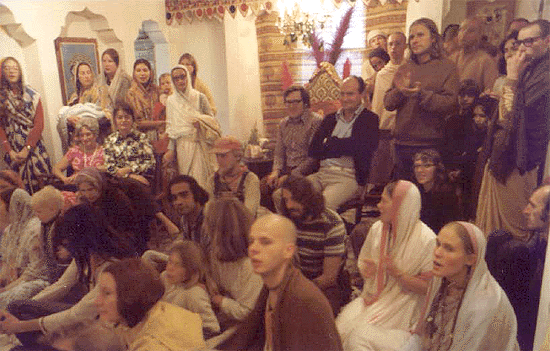

The Bridesville Farm, circa 1974
In the late afternoon, the Deities are awakened from their naps. In the larger temples, the pujari offers Their Lordships a complete change of clothing and fresh garlands. Otherwise, They may be re-dressed in the same outfits, perhaps with new jewelry and fresh garlands.
At around 4:00, the Deities are offered Vaikalika-bhoga and a dhupa-arati. Darsana is open for this arati and, depending on the temple's schedule, the curtains may remain open until sometime between 5:30 and 6:30, when the curtains close for offering of Sandhya-bhoga. If an evening Tulasi-puja is offered, it may take place while the curtains are closed for Sandhya-seva.
In India, evening is the time of day when most people come to visit the Deities. At sundown, around 6:00, the temples receive many congregational members who come to take darsana of the Deities. The temple is generally very busy from 4:30 to 8:00 in the evening.
Sandhya means 'early evening'. Between 6:00 and 7:00, the conch is sounded and the curtains open for the Sandhya-arati. This Sandhya puja, also called Gaura-arati, is a full arati and kirtana. The same kirtana songs are sung as during Mangala-arati, except that Sri Gurv-astakam is replaced with the Gaura-arati-kirtana (jaya jaya goracander). After the arati, prasadam is distributed and an evening class is held while the curtains remain open. The evening class is on Bhagavad-gita.
Between 8:00 and 8:30 the curtains are closed and the Deities are prepared for bedtime. Their Lordships are dressed in their pajamas and their garlands and jewelry are removed. Ratrikalika-bhoga offering is made, usually with hot milk and perhaps a sweet.
During this period, there is sometimes reading from the Krsna Book, and/or singing of bhajans, until the curtains open for the last arati of the day, the Sayana arati. A full arati and kirtana is performed while the Deities give darsana in their pajamas. Finally is Sayana seva, about 9:00, when darsana closes for the day.
Gaura-arati
from Gitavali by Srila Bhaktivinoda Thakura
1
jaya jaya goracander aratiko sobha
jahnavi-tata-vane jaga-mana-lolbha
jaga jana-mana-lobha
2
dakhine nitaicand, bame, gadadhara
nikate adwaita, srinivasa chatra-dhara
3
bosiyache goracand ratna-simhasane
arati koren brahma-adi deva-gane
4
narahari-adi kori' camara dhulaya
sanjaya-mukunda-basu-ghos-adi gaya
5
sankha baje ghanta baje baje karatala
madhura mrdanga baje parama rasala
sankha baja ghanta baje
madhur madhur madhur baje
6
bahu-koti candra jini vadana ujjvala
gala-dese bana-mala kore jhalamala
7
siva-suka-narada preme gada-gada
bhakativinoda dekhe gorara sampada
(1) All glories, all glories to the beautiful arati ceremony of Lord Caitanya. This Gaura-arati is taking place in a grove on the banks of the Jahnavi (Ganges) and is attracting the minds of all living entities in the universe.
(2) On Lord Caitanya's right side is Lord Nityananda and on His left is Sri Gadadhara. Nearby stands Sri Advaita, and Srivasa Thakura is holding an umbrella over Lord Caitanya's head.
(3) Lord Caitanya has sat down on a jeweled throne, and the demigods, headed by Lord Brahms, perform the arati ceremony
(4) Narahari Sarakara and other associates of Lord Caitanya fan Him with camaras, and devotees headed by Sanjaya Pandita, Mukunda Datta, and Vasu Ghosa sing sweet kirtana.
(5) Conchshells, bells, and karatalas resound, and the mrdangas play very sweetly. This kirtana music is supremely sweet and relish able to hear.
(6) The brilliance of Lord Caitanya's face conquers millions upon millions of moons, and the garland of forest flowers around His neck shines.
(7) Lord Siva, Sukadeva Gosvami, and Narada Muni are all there, and their voices are choked with the ecstasy of transcendental love. Thus Thakura Bhaktivinoda envisions the glory of Lord Sri Caitanya.
|

Bhajan and Kirtana Songs



|